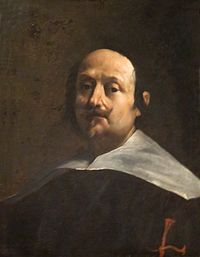Giovanni Lanfranco
Giovanni Lanfranco | |
|---|---|
 Self-portrait, between 1628 and 1632 | |
| Born | 26 January 1582 Parma, Italy |
| Died | 30 November 1647 (aged 65) Rome, Italy |
| Nationality | Italian |
| Known for | Painting |
| Movement | Baroque |
Giovanni Lanfranco (26 January 1582 – 30 November 1647)[1] was an Italian painter of the Baroque period.
Biography
Giovanni Gaspare Lanfranco was born in Parma, the third son of Stefano and Cornelia Lanfranchi, and was placed as a page in the household of Count Orazio Scotti. His talent for drawing allowed him to begin an apprenticeship with the Bolognese artist Agostino Carracci, brother of Annibale Carracci, working alongside fellow Parmese Sisto Badalocchio in the local Farnese palaces. When Agostino died in 1602, both young artists moved to Annibale's large and prominent Roman workshop, which was then involved in working on the Galleria Farnese in the Palazzo Farnese gallery ceiling.[2] Lanfranco is considered to have contributed to the panel of Polyphemus and Galatea (replica in Doria Gallery) and some minor works in the room.
Afterwards, while still technically a member of the Carracci studio of Carracci, Lanfranco, along with
Independent work


By 1605, Lanfranco was obtaining some independent commissions; for example, he contributed paintings to the Camerino degli Eremiti in the
After the death of Annibale Carracci in 1609, and with the Emilian school of painting temporarily out of favor, Lanfranco returned to his native Parma for two years. There, he met
Return to Rome
After his return to Rome by 1612, Lanfranco competed with other Carracci students and assistants—including Reni, Albani, and Domenichino—for Roman patronage. Reni, however, was soon to depart for Naples and then Bologna. During the following decades in Rome, through the 1620s, Lanfranco and Domenichino engaged in a rivalry for the main fresco commissions. A measure of the competition can be gauged from Lanfranco's public accusation, not wholly without merit, that Domenichino had plagiarized Agostino Carracci in his painting of the Confession of St. Jerome, now in the Vatican.
Unlike Domenichino, Lanfranco was fairly eclectic in terms of style but preferred a visionary, theatrical approach suitable for the ceiling paintings gaining currency in the early 17th century. His works suggest some influence from the late work of
Lanfranco's studio became quite active, painting frescoes in the

In the following year, Lanfranco together with
While Paul V's successor,


From 1634 to 1646, Lanfranco began decorating the dome and pendentives of the
Legacy and critical assessment
Lanfranco was a versatile and eclectic trainee of the Carracci, and continued their tradition with dramatic flair compared to the often restrained Domenichino, who mimicked mainly Annibale's grand manner. Lanfranco explored new styles, bridged traditions, painted in both mannerist and baroque styles, using a tenebrist and the colorist palette. Among his pupils was Giacinto Brandi.[8]
Selected works
- Venus plays the Harp, Galleria Nazionale d'Arte Antica, Rome (Palazzo Barberini)
- Alexander tended by the doctor and Alexander refusing water to drink from his men[9]
- The Annunciation (c. 1615–1624) San Carlo ai Catinari, Rome
- Coronation of the Virgin with St. Augustine and St. William of Aquitaine[10]
- Hagar in the Wilderness (Louvre)[11]
- Liberation of Saint Peter[12] (c. 1620–21), Birmingham Museum of Art, Alabama
- Palazzo Quirinale frescoes
References
- ISBN 978-0-19-102417-7.
- ^ a b c Williamson, George. "Giovanni Lanfranco." The Catholic Encyclopedia Vol. 8. New York: Robert Appleton Company, 1910. 8 December 2022
 This article incorporates text from this source, which is in the public domain.
This article incorporates text from this source, which is in the public domain.
- Capodimonte Museumin Naples; see Smith & O'Neil p. 484-6
- ^ Donati, Paolo. Nuova descrizione della città di Parma, Giuseppe Paganino, Parma (1824); p. 132.
- ^ Zirpolo, Lilian H., Historical Dictionary of Baroque Art and Architecture, 2nd Edition, (2018), p. 222.
- ^ Smith & O'Neil p490-92
- ^ Wittkower p 357
- ^ Orlandi, Pellegrino Antonio; Guarienti, Pietro (1719), Abecedario pittorico, Naples, p. 182
- ^ Fondazionemanodori.it Archived May 6, 2006, at the Wayback Machine
- ^ "Coronation of the Virgin with St Augustine and St William of Aquitaine by LANFRANCO, Giovanni". Wga.hu. Retrieved 2014-03-05.
- ^ "Hagar in the Wilderness by LANFRANCO, Giovanni". Wga.hu. Retrieved 2014-03-05.
- ^ "Collection Item Details - Birmingham Museum of Art". Archived from the original on 2013-04-14. Retrieved 2011-05-16.
![]() This article incorporates text from a publication now in the public domain: Herbermann, Charles, ed. (1913). "Giovanni Lanfranco". Catholic Encyclopedia. New York: Robert Appleton Company.
This article incorporates text from a publication now in the public domain: Herbermann, Charles, ed. (1913). "Giovanni Lanfranco". Catholic Encyclopedia. New York: Robert Appleton Company.
Sources
- Cropper, Elizabeth. Domenichino Affair. Washington: Center for Advanced Study in the Visual Arts, National Gallery of Art.
- Wittkower, Rudolf (1993). Art and Architecture Italy, 1600–1750. 1980. Penguin Books. pp. 80–88.
- Francis P. Smyth and John P. O'Neill, ed. (1986). The Age of Correggio and the Carracci: Emilian Painting of the 16th and 17th Centuries. Washington: National Gallery of Art. pp. 483–493.
External links
- Orazio and Artemisia Gentileschi, a fully digitized exhibition catalog from The Metropolitan Museum of Art Libraries, which contains material on Giovanni Lanfranco (see index)
- Lanfranco exhibition in Parma & Rome, with biography and many works[permanent dead link]
- Six works by Lanfranco, including Assumption of the Virgin
